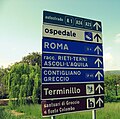
Futura is a geometric sans-serif typeface designed by Paul Renner and released in 1927. It was designed as a contribution on the New Frankfurt-project. It is based on geometric shapes, especially the circle, similar in spirit to the Bauhaus design style of the period. It was developed as a typeface by the Bauer Type Foundry, in competition with Ludwig & Mayer's seminal Erbar typeface of 1926.

Rail Alphabet is a neo-grotesque sans-serif typeface designed by Jock Kinneir and Margaret Calvert for signage on the British Rail network. First used at Liverpool Street station, it was then adopted by the Design Research Unit (DRU) as part of their comprehensive 1965 rebranding of the company.

Road signs in the United Kingdom and in its associated Crown dependencies and overseas territories conform broadly to European design norms, though a number of signs are unique: direction signs omit European route numbers and road signs generally use the Imperial System of units, unlike the rest of Europe. Signs in Wales and parts of Scotland are bilingual.

A street name sign is a type of traffic sign used to identify named roads, generally those that do not qualify as expressways or highways. Street name signs are most often found posted at intersections; sometimes, especially in the United States, in perpendicularly oriented pairs identifying each of the crossing streets.
Margaret Vivienne Calvert is a British typographer and graphic designer who, with colleague Jock Kinneir, designed many of the road signs used throughout the United Kingdom, Crown Dependencies, and British Overseas Territories, as well as the Transport font used on road signs, the Rail Alphabet font used on the British railway system, and an early version of the signs used in airports. The typeface developed by Kinneir and Calvert was further developed into New Transport and used for the single domain GOV.UK website in the United Kingdom.
Gaelic type is a family of Insular script typefaces devised for printing Classical Gaelic. It was widely used from the 16th century until the mid-18th century in Scotland and the mid-20th century in Ireland, but is now rarely used. Sometimes, all Gaelic typefaces are called Celtic or uncial although most Gaelic types are not uncials. The "Anglo-Saxon" types of the 17th century are included in this category because both the Anglo-Saxon types and the Gaelic/Irish types derive from the insular manuscript hand.
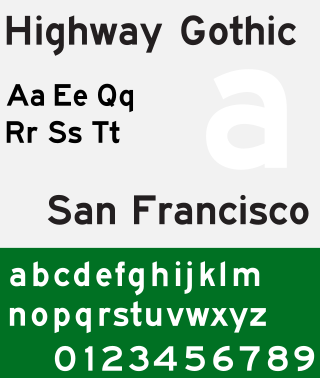
Highway Gothic is a sans-serif typeface developed by the United States Federal Highway Administration (FHWA) and used for road signage in the Americas, including the U.S., Canada, Latin America and some Caribbean countries, as well as in Asian countries influenced by American signage practices, including the Philippines, China, Taiwan, Malaysia, Indonesia and Thailand.
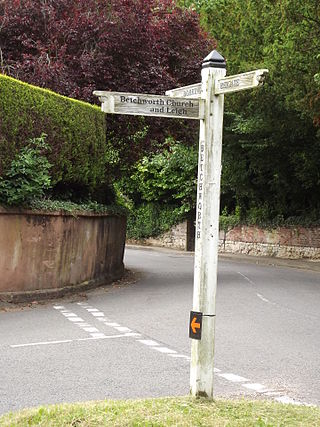
A fingerpost is a type of sign post consisting of a post with one or more arms, known as fingers, pointing in the direction of travel to places named on the fingers, often including distance information.

DIN 1451 is a sans-serif typeface that is widely used for traffic, administrative and technical applications.
Herbert Spencer was a British designer, editor, writer, photographer and teacher. He was born in London.

The Traffic Signs Regulations and General Directions is the law that sets out the design and conditions of use of official traffic signs that can be lawfully placed on or near roads in Great Britain and the Isle of Man. The regulations, originally introduced in 1965, were the result of the review of British road signage carried out by the Worboys Committee.
Richard "Jock" Kinneir was a British typographer and graphic designer who, with his colleague Margaret Calvert, designed many of the road signs used throughout the United Kingdom, Crown Dependencies, and British overseas territories. Their system has become a model for modern road signage.

European traffic signs present relevant differences between countries despite an apparent uniformity and standardisation. Most European countries refer to the 1968 Vienna Convention on Road Signs and Signals. The convention has been adopted by the following countries : Albania, Armenia, Austria, Belarus, Belgium, Bosnia and Herzegovina, Bulgaria, Croatia, Cyprus, the Czech Republic, Denmark, Estonia, Finland, France, Georgia, Germany, Greece, Hungary, Italy, Latvia, Liechtenstein, Lithuania, Luxembourg, Moldova, Montenegro, Netherlands, North Macedonia, Norway, Poland, Portugal, Romania, Russia, San Marino, Serbia, Slovakia, Slovenia, Spain, Sweden, Switzerland, Turkey, Ukraine and the United Kingdom. The convention has not been adopted by Ireland, Iceland or Malta.

Motorway is a sans-serif typeface designed by Jock Kinneir and Margaret Calvert for use on the motorway network of the United Kingdom. Motorway was first used on the M6 Preston bypass in 1958 and has been in use on the UK's motorways ever since. The typeface is also used in some other countries, most notably Ireland and Portugal.
Sir Walter John Worboys, was an Australian-born British businessman and chemist. He is best known for widely reforming road traffic signage in the United Kingdom.
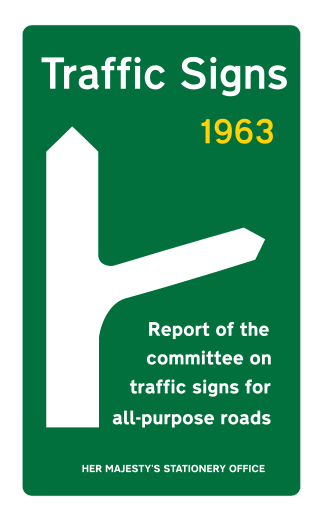
The Worboys Committee was formed by the British government to review signage on all British roads. In its July 1963 report Traffic signs: report of the committee on traffic signs for all-purpose roads, it found existing road signs to be obsolete for the increasing numbers of motor vehicles and their increasing speeds, and made over a dozen key recommendations. The committee went on to completely revise road signs in Britain, with an emphasis on symbols alone, adopting standard colour and shape practices used in mainland Europe and a new typeface. Its principles were adopted and are still the basis of all road signs in the United Kingdom.
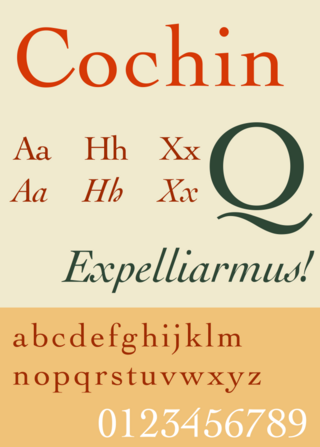
Cochin is a serif typeface. It was originally produced in 1912 by Georges Peignot for the Paris foundry G. Peignot et Fils and was based on the copperplate engravings of 18th century French artist Charles-Nicolas Cochin, from which the typeface also takes its name. The font has a small x-height with long ascenders. Georges Peignot also created the design 'Nicolas-Cochin' as a looser variation in the same style.

The Buenos Aires Visual Plan was the first program to establish an organised system of traffic signs in the city of Buenos Aires, developed and implemented between 1971 and 1972. The plan had been thought by the Buenos Aires administration led by then Intendent Saturnino Montero Ruiz and carried out by the design studio managed by architects Guilermo González Ruiz and Ronald Shakespear.
This article is a summary of traffic signs used in each country.






